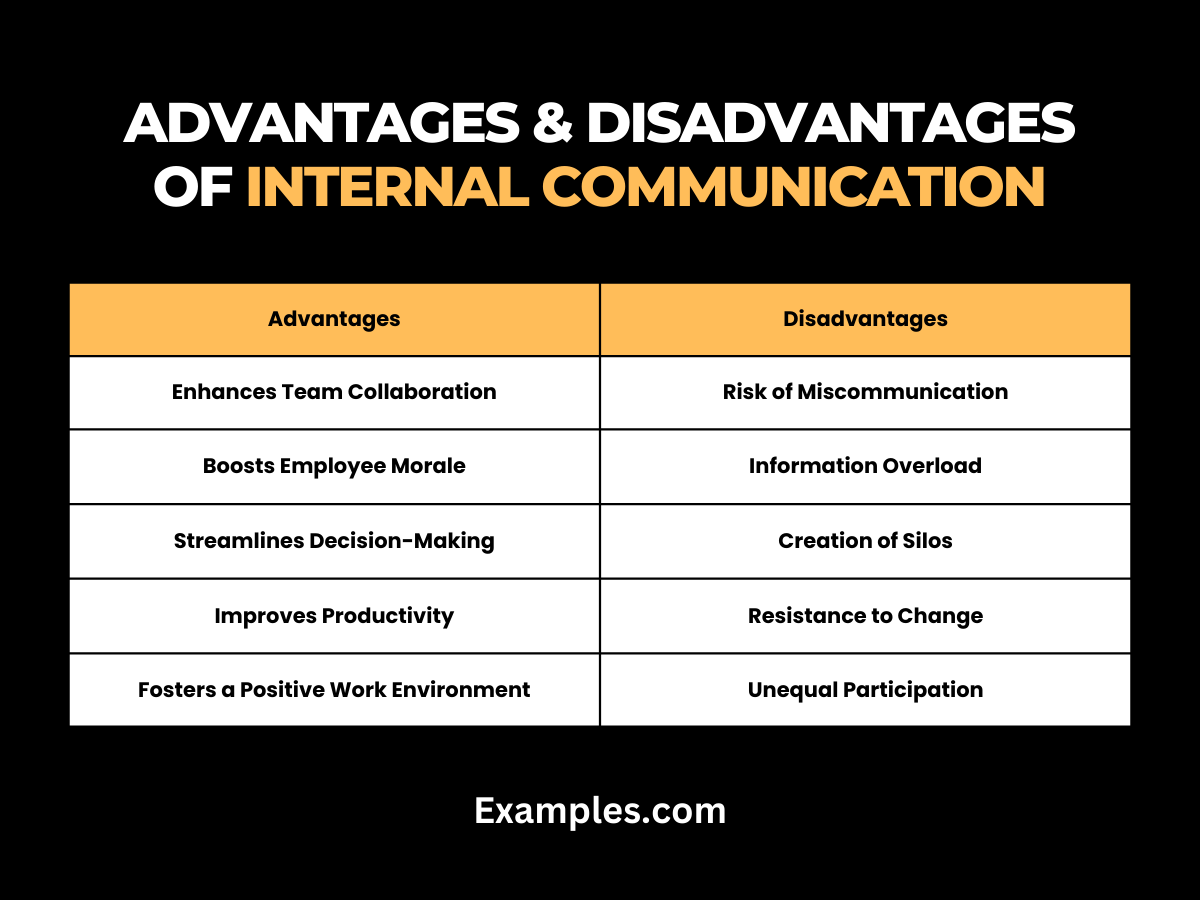Advantages & Disadvantages of Internal Communication Examples
In this comprehensive guide, we delve into the intricate world of Internal Communication, examining its various advantages and disadvantages. Understanding the dynamics of internal communication is crucial for any organization striving for excellence in effective communication. This guide not only highlights key examples but also provides insightful analysis on how internal communication strategies can significantly impact organizational efficiency and employee morale. From fostering a collaborative environment to navigating potential miscommunications, this guide is an invaluable resource for anyone looking to enhance their communication skills within a professional setting.
What are the Advantages and Disadvantages of Internal Communication?
Internal Communication refers to the exchange of information and ideas within an organization. It plays a pivotal role in shaping the workplace environment and influencing employee engagement. The advantages of effective internal communication include improved team collaboration, enhanced employee morale, and streamlined decision-making processes. Conversely, the disadvantages can involve the risk of miscommunication, potential information overload, and the creation of communication silos. Understanding these aspects is essential for developing a balanced and effective communication strategy.
Advantages and Disadvantages of Internal Communication

| Advantages of Internal Communication | Disadvantages of Internal Communication |
|---|---|
| Enhances Team Collaboration: Facilitates better understanding and cooperation among team members. | Risk of Miscommunication: Can lead to misunderstandings if not clear or effective. |
| Boosts Employee Morale: Good internal communication can increase job satisfaction and motivation. | Information Overload: Too much communication can overwhelm employees. |
| Streamlines Decision-Making: Efficient communication aids in faster and more informed decision-making. | Creation of Silos: Poor communication can lead to isolated groups within an organization. |
| Improves Productivity: Clear communication can lead to more efficient workflows and reduced downtime. | Resistance to Change: Some employees may resist new communication methods or tools. |
| Fosters a Positive Work Environment: Open communication contributes to a more supportive and engaging workplace. | Unequal Participation: Some voices may dominate, while others are unheard. |
| Encourages Innovation and Creativity: Open channels of communication can lead to new ideas and innovations. | Dependence on Technology: Heavy reliance on digital communication tools can be problematic if there are technical issues. |
| Builds Trust and Transparency: Regular and honest communication builds trust among employees and management. | Potential for Conflict: Misunderstandings or differing opinions can lead to conflicts. |
Advantages and Disadvantages of Internal Communication Essay
Internal communication is an essential component of any organization, playing a crucial role in shaping its success and employee well-being. This essay explores the various advantages and disadvantages of internal communication, underscoring its impact on organizational efficiency and employee dynamics.
Advantages of Internal Communication
- Enhanced Collaboration and Teamwork: Effective internal communication fosters better collaboration among employees. It ensures that everyone is on the same page, leading to a more cohesive work environment. This kind of effective communication promotes teamwork and helps in achieving common goals more efficiently.
- Improved Employee Morale and Engagement: Regular and transparent communication within an organization boosts employee morale. It makes the workforce feel valued and involved in the company’s affairs, which, in turn, enhances their engagement and commitment to their roles.
- Efficient Decision-Making and Problem-Solving: When communication channels are open and clear, decision-making becomes quicker and more effective. Employees are better informed, which allows them to contribute meaningfully to problem-solving processes and decision-making.
- Transparency and Trust Building: Open communication channels contribute to a transparent work environment. When information flows freely, it builds trust between employees and management, creating a more honest and open workplace culture.
- Innovation and Creativity Stimulation: Good internal communication encourages the sharing of ideas and innovation. It creates an environment where creative thoughts are welcomed and discussed, leading to innovative solutions and improvements.
Disadvantages of Internal Communication
- Risk of Miscommunication and Misunderstandings: One of the major pitfalls of internal communication is the risk of miscommunication. Misinterpreted or unclear messages can lead to confusion and errors in work.
- Information Overload: Excessive communication can lead to information overload, where employees feel overwhelmed with the amount of information they need to process. This can lead to decreased productivity and increased stress.
- Potential for Conflict: Different viewpoints and communication styles can lead to misunderstandings and conflicts among team members. If not managed properly, these conflicts can escalate and affect workplace harmony.
- Dependency on Technology: In today’s digital age, much of internal communication relies on technological tools. This dependency can become a disadvantage if there are technical issues or if employees are not equally tech-savvy.
- Exclusion and Inequality: Poorly managed communication can result in some employees feeling excluded. This can happen in large organizations where information may not reach every employee equally, leading to feelings of inequality and disenfranchisement.
Advantages and Disadvantages of Internal and External Communication
Certainly! Here’s a table outlining five key advantages and disadvantages of both internal and external communication:
| Internal Communication | External Communication |
|---|---|
| Advantages | Advantages |
| 1. Enhances collaboration and teamwork within the organization. | 1. Improves brand image and public perception. |
| 2. Boosts employee morale and engagement. | 2. Facilitates business partnerships and customer relationships. |
| 3. Aids in efficient decision-making and problem-solving. | 3. Expands market reach and helps in identifying new opportunities. |
| 4. Promotes transparency and trust among employees. | 4. Provides valuable feedback from customers and stakeholders. |
| 5. Encourages innovation and idea sharing within the company. | 5. Enhances company’s reputation and credibility in the market. |
| Disadvantages | Disadvantages |
| 1. Risk of miscommunication and misunderstandings. | 1. Risk of misrepresenting the company’s message or values. |
| 2. Can lead to information overload and employee burnout. | 2. Public criticism or negative feedback can impact brand image. |
| 3. Potential for conflict and disagreements among staff. | 3. Requires careful management to maintain consistent messaging. |
| 4. Dependency on technology can lead to communication breakdowns. | 4. Can be costly, especially for extensive marketing and PR campaigns. |
| 5. Inequality in information distribution can create disparities. | 5. Risk of sensitive information leakage damaging the company’s position. |
In conclusion, understanding the advantages and disadvantages of internal communication is crucial for any organization. This guide offers insights and practical examples to navigate these dynamics effectively. By embracing clear and inclusive communication strategies, companies can enhance team collaboration, boost morale, and avoid potential pitfalls, ultimately leading to a more cohesive and productive work environment.



